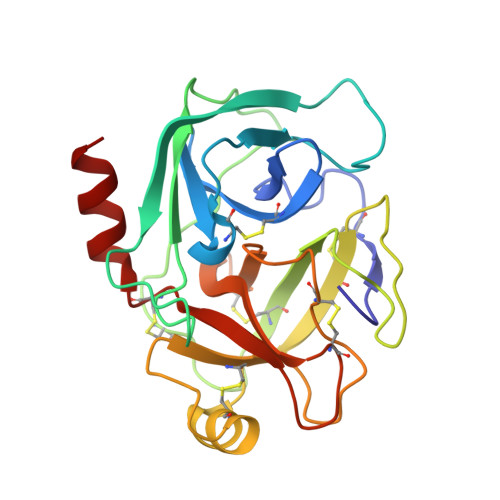L-Isoaspartate 115 of porcine beta-trypsin promotes crystallization of its complex with bdellastasin.
Rester, U., Moser, M., Huber, R., Bode, W.(2000) Acta Crystallogr D Biol Crystallogr 56: 581-588
- PubMed: 10771427
- DOI: https://doi.org/10.1107/s0907444900003048
- Primary Citation of Related Structures:
1EJA - PubMed Abstract:
Bdellastasin is a 59-amino-acid, cysteine-rich, antistasin-type inhibitor of sperm acrosin, plasmin and trypsin, isolated from the medicinal leech Hirudo medicinalis. The complex formed between bdellastasin and porcine beta-trypsin has previously been crystallized in the presence of PEG in a tetragonal crystal form of space group P4(3)2(1)2 and has now been found to crystallize under high-salt conditions in the enantiomorphic space group P4(1)2(1)2. These structures have been solved and refined to 2.8 and 2.7 A resolution, respectively. Bdellastasin turns out to have an antistasin-like fold exhibiting a bis-domainal structure. In the second new crystal form, the flexible N-terminal subdomain is rotated with respect to the C--terminal subdomain by about 90 degrees, fitting into a cavity formed by symmetry-related trypsin molecules. The canonical inhibitor-proteinase interaction is restricted to the primary binding loop comprising residues Leu31-Lys36 of bdellastasin. During the refinement, a bound sodium ion occupying the calcium-binding site of the porcine beta-trypsin component was discovered. This sodium ion is coordinated in a tetragonal-pyramidal manner, with the geometry of the enclosing loop slightly changed compared with the loop in the presence of calcium. In the crystal form of space group P4(3)2(1)2, the electron density for residue 115 of porcine beta-trypsin clearly indicates the presence of a beta-isomerized L-aspartic acid, which is placed in spatial proximity to segment Thr144--Gly148 of a symmetry-related trypsin molecule. This is the first structurally observed example of an L-isoaspartate in beta--trypsin originating from Asn. A comparison with other known crystal structures of porcine beta-trypsin-macromolecular inhibitor complexes suggests that the deamidation, isomerization and racemization of Asn115 is the key step in crystallization.
Organizational Affiliation:
Max-Planck-Institut für Biochemie, Abteilung Strukturforschung, Am Klopferspitz 18a, 82152 Martinsried, Germany.
















